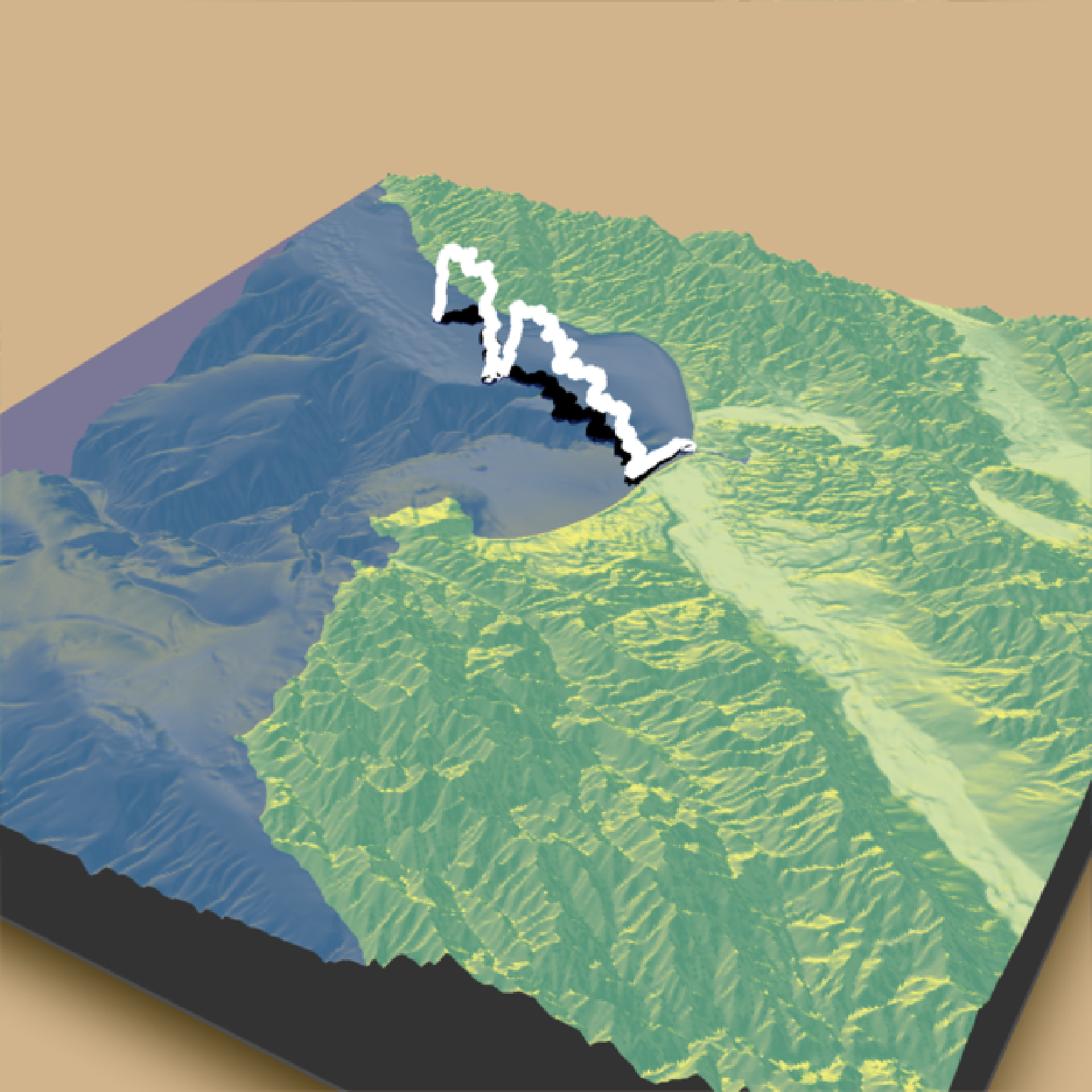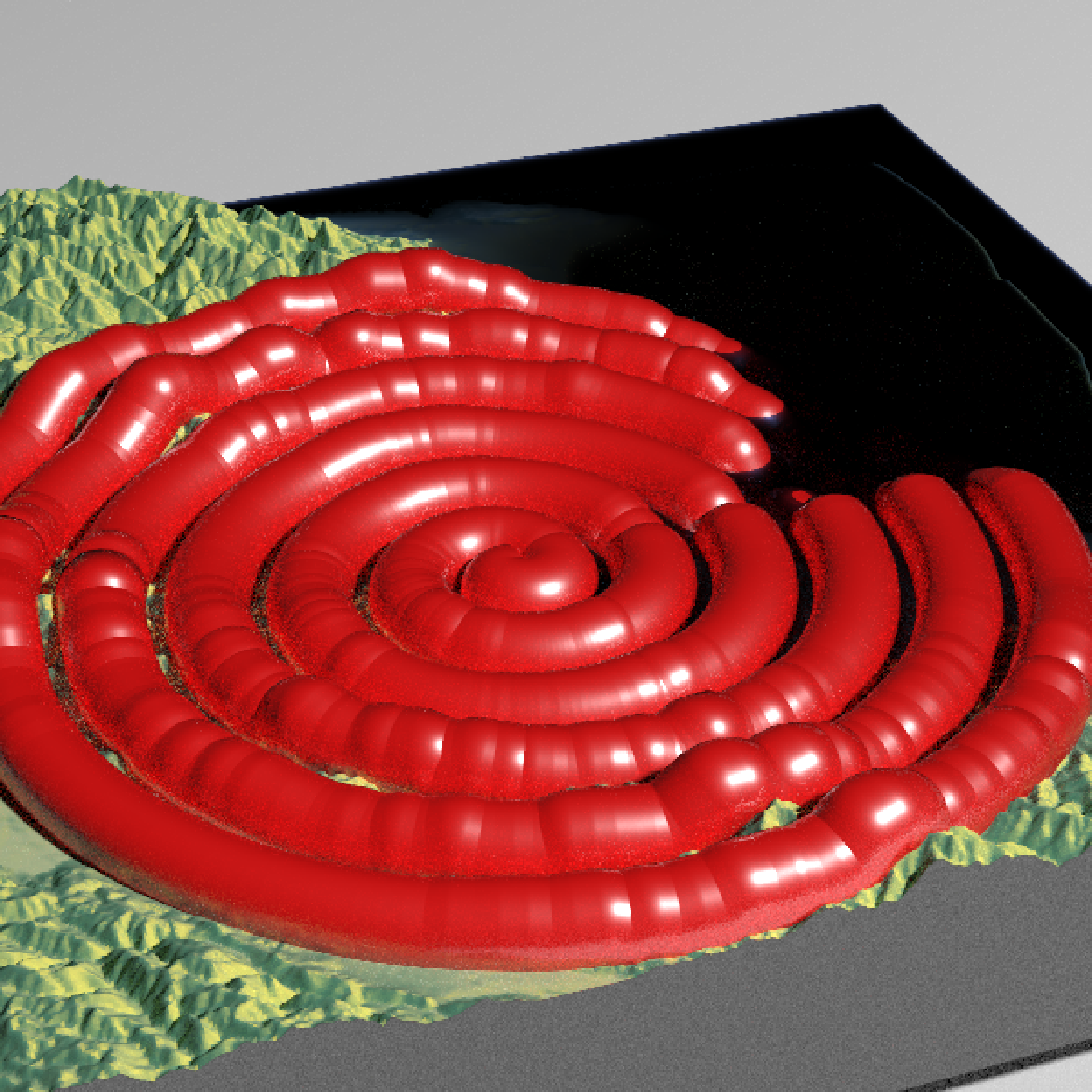Adds a 3D path to the current scene, using latitude/longitude or coordinates in the reference system defined by the extent object. If no altitude is provided, the path will be elevated a constant offset above the heightmap. If the path goes off the edge, the nearest height on the heightmap will be used.
render_path(
lat,
long = NULL,
altitude = NULL,
groups = NULL,
extent = NULL,
zscale = 1,
heightmap = NULL,
resample_evenly = FALSE,
resample_n = 360,
reorder = FALSE,
reorder_first_index = 1,
reorder_duplicate_tolerance = 0.1,
reorder_merge_tolerance = 1,
simplify_tolerance = 0,
linewidth = 3,
color = "black",
antialias = FALSE,
offset = 5,
clear_previous = FALSE,
return_coords = FALSE,
tag = "path3d"
)Arguments
- lat
Vector of latitudes (or other coordinate in the same coordinate reference system as extent). Can also be an `sf` or `SpatialLineDataFrame` object.
- long
Default `NULL`. Vector of longitudes (or other coordinate in the same coordinate reference system as extent). Ignored if lat is an `sf` or `SpatialLineDataFrame` object.
- altitude
Default `NULL`. Elevation of each point, in units of the elevation matrix (scaled by zscale). If left `NULL`, this will be just the elevation value at ths surface, offset by `offset`. If a single value, all data will be rendered at that altitude.
- groups
Default `NULL`. Integer vector specifying the grouping of each lat/long path segment, if lat/long are specified as numeric vectors (as opposed to `sf` or `SpatialLineDataFrame` objects, where this information is built-in to the object).
- extent
Either an object representing the spatial extent of the 3D scene (either from the `raster`, `terra`, `sf`, or `sp` packages), a length-4 numeric vector specifying `c("xmin", "xmax","ymin","ymax")`, or the spatial object (from the previously aforementioned packages) which will be automatically converted to an extent object.
- zscale
Default `1`. The ratio between the x and y spacing (which are assumed to be equal) and the z axis in the original heightmap.
- heightmap
Default `NULL`. Pass this if not including an `altitude` argument, or if no extent passed. A two-dimensional matrix, where each entry in the matrix is the elevation at that point. All points are assumed to be evenly spaced.
- resample_evenly
Default `FALSE`. If `TRUE`, this will re-sample the path evenly from beginning to end, which can help vastly reduce the number of points used to draw it (which can improve the performance of `render_highquality()` and `render_snapshot(software_render = TRUE)`). This function works only if `reorder = TRUE`, or if the sf object is already ordered from beginning to end.
- resample_n
Default `360`. Number of breaks in which to evenly resample the line if `resample_evenly = TRUE`.
- reorder
Default `FALSE`. If `TRUE`, this will attempt to re-order the rows within an `sf` object with multiple paths to be one continuous, end-to-end path. This happens in two steps: merging duplicate paths that have end points that match with another object (within `reorder_duplicate_tolerance` distance), and then merges them (within `reorder_merge_tolerance` distance) to form a continuous path.
- reorder_first_index
Default `1`. The index (row) of the `sf` object in which to begin the reordering process. This merges and reorders paths within `reorder_merge_tolerance` distance until it cannot merge any more, and then repeats the process in the opposite direction.
- reorder_duplicate_tolerance
Default `0.1`. Lines that have start and end points (does not matter which) within this tolerance that match a line already processed (order determined by `reorder_first_index`) will be discarded.
- reorder_merge_tolerance
Default `1`. Lines that have start points that are within this distance to a previously processed line's end point (order determined by `reorder_first_index`) will be reordered within the `sf` object to form a continuous, end-to-end path.
- simplify_tolerance
Default `0` (no simplification). If greater than zero, simplifies the path to the tolerance specified. This happens after the data has been merged if `reorder = TRUE`. If the input data is specified with long-lat coordinates and `sf_use_s2()` returns `TRUE`, then the value of simplify_tolerance must be specified in meters.
- linewidth
Default `3`. The line width.
- color
Default `black`. Color of the line.
- antialias
Default `FALSE`. If `TRUE`, the line with be have anti-aliasing applied. NOTE: anti-aliasing can cause some unpredictable behavior with transparent surfaces.
- offset
Default `5`. Offset of the track from the surface, if `altitude = NULL`.
- clear_previous
Default `FALSE`. If `TRUE`, it will clear all existing paths.
- return_coords
Default `FALSE`. If `TRUE`, this will return the internal rayshader coordinates of the path, instead of plotting the line.
- tag
Default `"path3d"`. The rgl tag to use when adding the path to the scene.
Examples
if(run_documentation()) {
#Starting at Moss Landing in Monterey Bay, we are going to simulate a flight of a bird going
#out to sea and diving for food.
#First, create simulated lat/long data
set.seed(2009)
moss_landing_coord = c(36.806807, -121.793332)
x_vel_out = -0.001 + rnorm(1000)[1:300]/1000
y_vel_out = rnorm(1000)[1:300]/200
z_out = c(seq(0,2000,length.out = 180), seq(2000,0,length.out=10),
seq(0,2000,length.out = 100), seq(2000,0,length.out=10))
bird_track_lat = list()
bird_track_long = list()
bird_track_lat[[1]] = moss_landing_coord[1]
bird_track_long[[1]] = moss_landing_coord[2]
for(i in 2:300) {
bird_track_lat[[i]] = bird_track_lat[[i-1]] + y_vel_out[i]
bird_track_long[[i]] = bird_track_long[[i-1]] + x_vel_out[i]
}
#Render the 3D map
montereybay %>%
sphere_shade() %>%
plot_3d(montereybay,zscale=50,water=TRUE,
shadowcolor="#40310a", watercolor="#233aa1", background = "tan",
theta=210, phi=22, zoom=0.20, fov=55)
#Pass in the extent of the underlying raster (stored in an attribute for the montereybay
#dataset) and the latitudes, longitudes, and altitudes of the track.
render_path(extent = attr(montereybay,"extent"),
lat = unlist(bird_track_lat), long = unlist(bird_track_long),
altitude = z_out, zscale=50,color="white", antialias=TRUE)
render_snapshot()
}
 if(run_documentation()) {
#We'll set the altitude to right above the water to give the tracks a "shadow".
render_path(extent = attr(montereybay,"extent"),
lat = unlist(bird_track_lat), long = unlist(bird_track_long),
altitude = 10, zscale=50, color="black", antialias=TRUE)
render_camera(theta=30,phi=35,zoom=0.45,fov=70)
render_snapshot()
}
if(run_documentation()) {
#We'll set the altitude to right above the water to give the tracks a "shadow".
render_path(extent = attr(montereybay,"extent"),
lat = unlist(bird_track_lat), long = unlist(bird_track_long),
altitude = 10, zscale=50, color="black", antialias=TRUE)
render_camera(theta=30,phi=35,zoom=0.45,fov=70)
render_snapshot()
}
 if(run_documentation()) {
#Remove the path:
render_path(clear_previous=TRUE)
#Finally, we can also plot just GPS coordinates offset from the surface by leaving altitude `NULL`
# Here we plot a spiral of values surrounding Moss Landing. This requires the original heightmap.
t = seq(0,2*pi,length.out=1000)
circle_coords_lat = moss_landing_coord[1] + 0.5 * t/8 * sin(t*6)
circle_coords_long = moss_landing_coord[2] + 0.5 * t/8 * cos(t*6)
render_path(extent = attr(montereybay,"extent"), heightmap = montereybay,
lat = unlist(circle_coords_lat), long = unlist(circle_coords_long),
zscale=50, color="red", antialias=TRUE,offset=100, linewidth=5)
render_camera(theta = 160, phi=33, zoom=0.4, fov=55)
render_snapshot()
}
if(run_documentation()) {
#Remove the path:
render_path(clear_previous=TRUE)
#Finally, we can also plot just GPS coordinates offset from the surface by leaving altitude `NULL`
# Here we plot a spiral of values surrounding Moss Landing. This requires the original heightmap.
t = seq(0,2*pi,length.out=1000)
circle_coords_lat = moss_landing_coord[1] + 0.5 * t/8 * sin(t*6)
circle_coords_long = moss_landing_coord[2] + 0.5 * t/8 * cos(t*6)
render_path(extent = attr(montereybay,"extent"), heightmap = montereybay,
lat = unlist(circle_coords_lat), long = unlist(circle_coords_long),
zscale=50, color="red", antialias=TRUE,offset=100, linewidth=5)
render_camera(theta = 160, phi=33, zoom=0.4, fov=55)
render_snapshot()
}
 if(run_documentation()) {
#And all of these work with `render_highquality()`. Here, I set `use_extruded_paths = TRUE`
#to get thick continuous paths.
render_highquality(clamp_value=10, line_radius=3, min_variance = 0,
use_extruded_paths = TRUE,
sample_method = "sobol_blue", samples = 128)
}
#> Warning: material set as vertex color but no texture or bump map passed--ignoring mesh3d material.
if(run_documentation()) {
#And all of these work with `render_highquality()`. Here, I set `use_extruded_paths = TRUE`
#to get thick continuous paths.
render_highquality(clamp_value=10, line_radius=3, min_variance = 0,
use_extruded_paths = TRUE,
sample_method = "sobol_blue", samples = 128)
}
#> Warning: material set as vertex color but no texture or bump map passed--ignoring mesh3d material.
 if(run_documentation()) {
#We can also change the material of the objects by setting the `point_material` and
#`point_material_args` arguments in `render_highquality()`
render_highquality(clamp_value=10, line_radius=3, min_variance = 0,
sample_method = "sobol_blue", samples = 128,
path_material = rayrender::glossy, use_extruded_paths = TRUE,
path_material_args = list(gloss = 0.5, reflectance = 0.2))
}
#> Warning: material set as vertex color but no texture or bump map passed--ignoring mesh3d material.
if(run_documentation()) {
#We can also change the material of the objects by setting the `point_material` and
#`point_material_args` arguments in `render_highquality()`
render_highquality(clamp_value=10, line_radius=3, min_variance = 0,
sample_method = "sobol_blue", samples = 128,
path_material = rayrender::glossy, use_extruded_paths = TRUE,
path_material_args = list(gloss = 0.5, reflectance = 0.2))
}
#> Warning: material set as vertex color but no texture or bump map passed--ignoring mesh3d material.
 if(run_documentation()) {
#For transmissive materials (like `dielectric`), we should specify that the path
#should be rendered with an extruded path. We'll use the `attenuation` argument in
#the `dielectric` function to specify a realistic glass color.
render_path(extent = attr(montereybay,"extent"), heightmap = montereybay, clear_previous = TRUE,
lat = unlist(circle_coords_lat), long = unlist(circle_coords_long),
zscale=50, color="white", offset=200, linewidth=5)
render_highquality(clamp_value=10, line_radius=6, min_variance = 0,
sample_method = "sobol_blue", samples = 128,
lightsize = 2000, lightintensity = 10,
path_material = rayrender::dielectric, use_extruded_paths = TRUE,
path_material_args = list(refraction = 1.5, attenuation = c(0.05,0.2,0.2)))
}
#> Warning: material set as vertex color but no texture or bump map passed--ignoring mesh3d material.
if(run_documentation()) {
#For transmissive materials (like `dielectric`), we should specify that the path
#should be rendered with an extruded path. We'll use the `attenuation` argument in
#the `dielectric` function to specify a realistic glass color.
render_path(extent = attr(montereybay,"extent"), heightmap = montereybay, clear_previous = TRUE,
lat = unlist(circle_coords_lat), long = unlist(circle_coords_long),
zscale=50, color="white", offset=200, linewidth=5)
render_highquality(clamp_value=10, line_radius=6, min_variance = 0,
sample_method = "sobol_blue", samples = 128,
lightsize = 2000, lightintensity = 10,
path_material = rayrender::dielectric, use_extruded_paths = TRUE,
path_material_args = list(refraction = 1.5, attenuation = c(0.05,0.2,0.2)))
}
#> Warning: material set as vertex color but no texture or bump map passed--ignoring mesh3d material.
